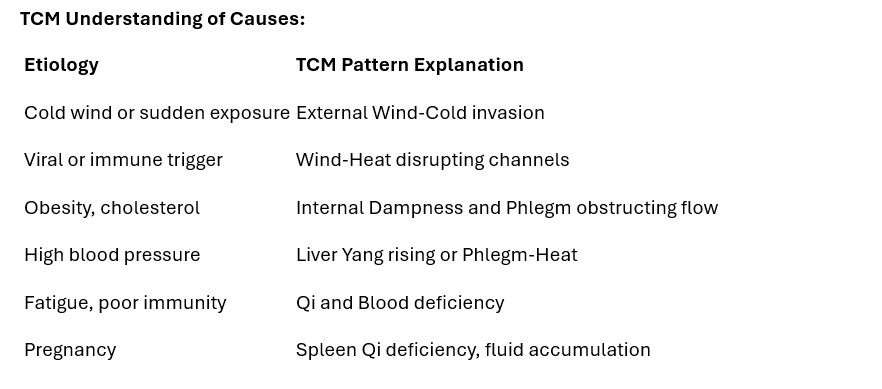Not All Facial Paralysis Is the Same: Bell’s Palsy, Stroke, and Cerebral Palsy Explained—and How TCM Treats Them Differently
Facial paralysis is often misunderstood. Whether it's a sudden droop on one side of the face or long-term asymmetry, many assume the cause is a stroke or permanent nerve damage. But did you know there are different types of facial paralysis—with distinct causes, prognoses, and treatments?
This guide breaks down the differences between Bell’s palsy, stroke-related facial paralysis, and cerebral palsy-related facial asymmetry—and explains how Traditional Chinese Medicine (TCM) offers natural, effective treatment options, especially for Bell’s palsy.
Bell’s Palsy vs. Stroke vs. Cerebral Palsy
Understanding the pattern of weakness (full vs. partial facial paralysis), timing, and presence of systemic symptoms helps distinguish among the three.
Bell’s Palsy: Key Signs & Root Causes
Bell’s palsy is the most common cause of sudden, one-sided facial paralysis. Most people recover within 3–6 months, but some are left with lasting stiffness, weakness, or asymmetry.
Common Signs:
Drooping mouth or eyelid on one side
Inability to close one eye
Loss of taste or tear control
No limb weakness or speech issues
Western Medicine Etiologies:
Viral infection (e.g., HSV-1, varicella-zoster)
Autoimmune response
Cold wind exposure
Stress or immune suppression
Obesity, hypertension, high cholesterol
Third-trimester pregnancy
TCM Understanding of Causes:
How TCM Treats Bell’s Palsy
Traditional Chinese Medicine doesn’t take a passive approach. It actively stimulates nerve healing, restores facial symmetry, and addresses the root imbalance.
Acupuncture
Facial and scalp acupuncture is highly effective—especially when started early (within 7–14 days). Benefits include:
Improved nerve conduction and circulation
Muscle reactivation and tone balance
Inflammation reduction
Key points may include:
ST4, ST6, ST7 (local), LI4 (distal), GB20 (wind clearing), SJ17, Taiyang
Herbal Medicine
Herbs are tailored to the person’s constitution and pattern. Examples:
Qian Zheng San – For facial deviation from Wind-Cold
Bu Yang Huan Wu Tang – For delayed recovery or post-stroke nerve healing
Er Chen Tang + Zhi Bai Di Huang Wan – For Phlegm-Heat obstruction with Liver/Kidney deficiency
What About Stroke-Related Facial Paralysis?
Facial paralysis after stroke usually affects the lower half of the face and is accompanied by:
Weakness or numbness in arms/legs
Slurred speech
Dizziness or visual changes
TCM Approach
Post-stroke paralysis is seen as internal Wind from Liver imbalance or Blood stasis obstructing channels. Treatment focuses on:
Unblocking meridians
Nourishing Liver and Kidney
Restoring motor function
Treatment may take longer, but TCM is often used in rehabilitation alongside physiotherapy.
What About Facial Asymmetry from Cerebral Palsy?
In children with CP, facial tone imbalance develops over time, often from birth trauma or brain oxygen deprivation. It may worsen with growth or stress.
TCM Approach
While CP cannot be reversed, TCM can support:
Improved facial tone
Better speech/swallowing
General brain and Spleen Qi nourishment
Herbs and acupuncture focus on:
Phlegm resolution
Qi and Essence strengthening
Liver Wind calming
This care is long-term and best combined with physical therapy.
Final Thoughts: Know the Difference, Treat the Root
Facial paralysis may look similar on the surface, but causes vary widely. That’s why accurate diagnosis and root-focused treatment are critical.
Bell’s palsy responds extremely well to early TCM treatment
Stroke paralysis requires integrative rehab—including acupuncture
Cerebral palsy-related asymmetry can benefit from supportive TCM care, though not curative
Ready for Natural Facial Recovery?
At JD AcuCare in Calgary, we specialize in:
Facial acupuncture for Bell’s palsy and stroke
Individualized herbal prescriptions
Non-invasive support for children with CP
Early intervention for faster, more complete recovery
📞 Book your consultation today and take control of your healing.



